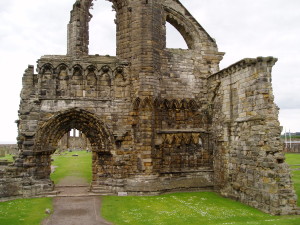The Middle Ages in the Modern World: Part Three

The ruins of St Andrews Cathedral. At 119 metres (391 feet) in length, it’s the largest church ever to have been built in Scotland.
As well as giving a paper of my own on representing the Middle Ages in fiction, I also had the chance to meet and share ideas with historians and people from a wide range of other academic disciplines whose work involves the medieval in one way or another.
I was also privileged to be able to attend the lecture that closed the conference, which was delivered by Nobel Prize-winning poet Seamus Heaney in what was probably one of his final public appearances before he died just a couple of months later.
Five of the keynote lectures, including Heaney’s, were recorded on video and have now been posted on the conference website for anyone interested in getting a taste of what the conference was all about. The five lectures are:
Saints’ cults and celebrity: the medieval legacy
James Robinson (National Museums Scotland)
Adapting medieval romance
Felicitas Hoppe (author and translator)
The worlding of medievalism: past and present in the early anthropocene
Bruce Holsinger (University of Virginia)
European ethnicity: does Europe have too much past?
Patrick Geary (Institute for Advanced Study, Princeton)
“Feinyit Fablis and Ane Cairfull Dyt”?: a Reading with Commentary
Seamus Heaney (Nobel Prize-winning poet)
The week following the conference, the British Academy in London held a special event with Patrick Geary and broadcaster, actor and writer Terry Jones, chaired by Dr Chris Jones from the University of St Andrews, in which they reprised their presentations and discussed the continuing relevance of the Middle Ages. The video of this event is also now online on the British Academy website.
All of the lectures are well worth watching if you have the chance. Between them they give a fairly good idea of the variety of subjects that were discussed over the four days, exploring how ideas and misconceptions of the Middle Ages have informed, and are reflected, in disciplines as wide-ranging as literature, politics and even climatology, which was the focus of Bruce Holsinger’s particularly excellent talk – just one of my many highlights of the conference.
In case you missed them the first time around, catch up with Part One and Part Two of my report from “The Middle Ages in the Modern World”.


















